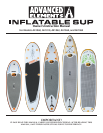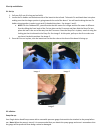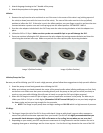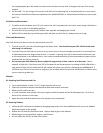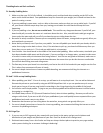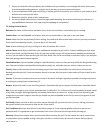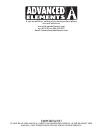7 Paddling Basics and Do’s and Don’ts
7.1 StandUp Paddling Basics
1. Make sure that your SUP is fully inflated. It should be nearly rock hard and when standing on the SUP in the
water and it should not bend. Your paddleboard may flex some with your weight, but it should not bend to the
point of creating a crease.
2. If you are paddling in open water, such as a lake or the ocean, make sure that you use an ankle leash. If you fall
off, your board could be swept away from you, leaving you stranded. An ankle leash will keep this from
happening.
3. If you are paddling a river, do not use an ankle leash. This could be very dangerous because if you fall off, your
board could pull you under the water as it continues down the river. Also, an ankle leash could get caught on
items under the water and pull you off of your board as you are riding down the river.
4. Be careful in windy conditions. Because you are completely above the water, strong winds can greatly affect you
and could push you around.
5. Never leave your board, even if you lose your paddle. You can still paddle your board with your hands, which is
easier than trying to swim back to shore. Also, if the wind was to pick up, your board will blow away from you
faster than you can swim to it. This is why an ankle leash is so important.
6. Foot Position: You should stand in the middle of the board when paddling. When on flat water, stand with your
feet about shoulder width apart and face forward. If you are surfing or in choppy water, you want to take more
of a surfer’s stance with your dominant foot facing forward. Your feet are not glued to the board, make sure to
get used to moving your feet around on the board because the sooner that you do this the more comfortable
you will feel about doing turns and riding waves.
7. The Best way to turn your board is to stand with your foot at the tail of the board with your weight over the fins.
This is where foot movement will come in handy.
8. For more in depth instructions or lessons on paddle boarding, we recommend utilizing the internet or a
paddleboard instructor.
7.2 Hula™ 11 Sit-on-top Paddling Basics
1. When paddling your Hula™ 11 as a sit-on-top, you will want a sit-on-top kayak seat. You can add an Advanced
Elements Kayak seat to your board by using our AE2502 Kayak Seat Link or you can purchase any sit-on-top
kayak seat as long as it has two snap hooks for attaching to the d-rings located at the middle of the board.
2. You will also need a kayak paddle. Trying to use your stand up paddle will be difficult because it will be hard to
keep going in a straight line.
3. You should always wear a PFD (Personal Floatation Device) when sit down paddling. Because you will not be
using an ankle leash; if you were to fall off of your paddleboard, you could quickly become separated from your
paddleboard and need a way to stay afloat.
4. Remember that because you are sitting above the waterline, strong winds can greatly affect you.
5. For more in depth instructions or lessons for sit-on-top paddling, we recommend utilizing the internet or other
resources for paddling techniques.
7.2 SUP Yoga Tips
1. If you are new to SUP in general, play around with your board on the water and get used to balance and
distribution of your weight and placement of your feet. Don’t be afraid to fall in and get wet!
2. Sheltered waters away from a lot of wake and chop are always the best places to practice your yoga routine,
unless you are looking for an extreme challenge in balancing!



